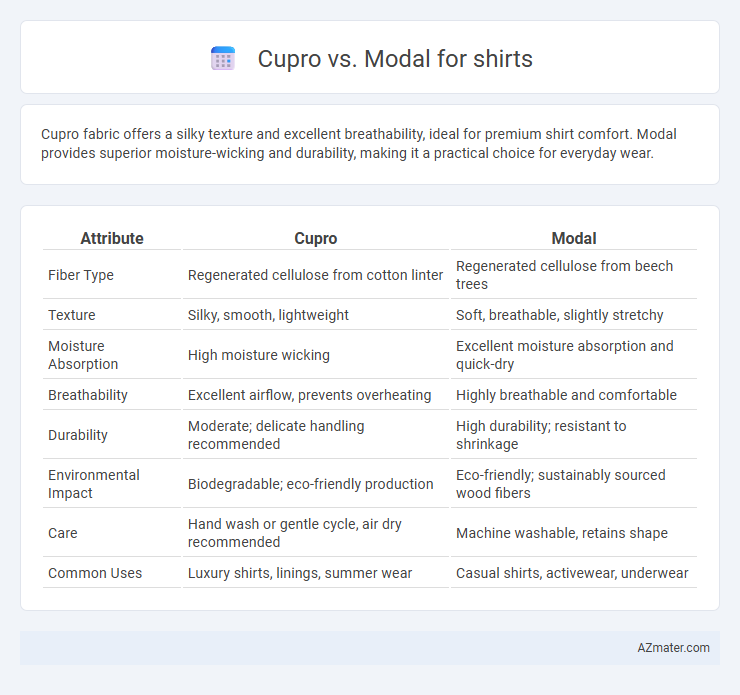Cupro fabric offers a silky texture and excellent breathability, ideal for premium shirt comfort. Modal provides superior moisture-wicking and durability, making it a practical choice for everyday wear.
Table of Comparison
| Attribute | Cupro | Modal |
|---|---|---|
| Fiber Type | Regenerated cellulose from cotton linter | Regenerated cellulose from beech trees |
| Texture | Silky, smooth, lightweight | Soft, breathable, slightly stretchy |
| Moisture Absorption | High moisture wicking | Excellent moisture absorption and quick-dry |
| Breathability | Excellent airflow, prevents overheating | Highly breathable and comfortable |
| Durability | Moderate; delicate handling recommended | High durability; resistant to shrinkage |
| Environmental Impact | Biodegradable; eco-friendly production | Eco-friendly; sustainably sourced wood fibers |
| Care | Hand wash or gentle cycle, air dry recommended | Machine washable, retains shape |
| Common Uses | Luxury shirts, linings, summer wear | Casual shirts, activewear, underwear |
Introduction to Cupro and Modal Fabrics
Cupro fabric, derived from regenerated cellulose fibers made from cotton linter, offers a silky texture and excellent breathability, making it ideal for lightweight and breathable shirts. Modal, produced from beech tree cellulose, is prized for its softness, moisture-wicking properties, and durability, providing a smooth feel and enhanced comfort in shirt fabrics. Both Cupro and Modal are eco-friendly alternatives to synthetic fibers, favored for their sustainability and luxurious performance in garment manufacturing.
Origins and Manufacturing Processes
Cupro, derived from cotton linter, undergoes a chemical process involving copper salts to create a smooth, breathable fabric, making it a regenerated cellulose fiber sourced primarily from cotton waste. Modal originates from beech tree pulp, produced through a more environmentally friendly, closed-loop process that recycles water and chemicals, resulting in a soft, moisture-wicking fabric. Both fabrics are semi-synthetic, but Cupro's production is more intensive in chemical processing, whereas Modal emphasizes sustainable forestry and eco-conscious manufacturing techniques.
Environmental Impact and Sustainability
Cupro fabric, made from regenerated cellulose fibers derived from cotton linter waste, offers a biodegradable and eco-friendly alternative in shirt production, reducing textile waste and chemical use compared to conventional fibers. Modal, sourced from sustainably managed beechwood forests, features a closed-loop production process that minimizes water and energy consumption, enhancing its low environmental impact profile. Both fabrics contribute to sustainable fashion, yet Cupro excels in waste valorization while Modal emphasizes renewable raw materials and efficient manufacturing.
Texture and Feel: Comfort Comparison
Cupro fabric offers a silky, smooth texture with a breathable, lightweight feel that enhances comfort in warm weather. Modal is known for its soft, supple touch and excellent moisture-wicking properties, providing a cool, comfortable experience on the skin. Both fibers are highly breathable and gentle, but Cupro's silk-like finish tends to feel more luxurious, while Modal delivers extra softness and stretch for active wear.
Breathability and Moisture-Wicking Properties
Cupro fabric offers excellent breathability due to its natural cellulose fibers, allowing air to flow freely and helping to regulate body temperature. Modal is highly moisture-wicking, absorbing up to 50% more moisture than cotton, which keeps the skin dry and comfortable during wear. Both materials excel in softness and comfort, but Cupro is preferable for enhanced airflow while Modal is superior in moisture management for shirts.
Durability and Longevity
Cupro fabric offers exceptional durability due to its fine cellulose fibers derived from cotton linter, making it resistant to pilling and wear over time. Modal, made from beech tree pulp, provides softness but tends to have a shorter lifespan as it can lose strength after repeated washing. When choosing between Cupro and Modal for shirts, Cupro generally delivers longer-lasting quality and maintains its structural integrity better during regular use.
Color Retention and Dye Affinity
Cupro fabric exhibits superior color retention due to its cellulose-based fibers that hold dye molecules more effectively, resulting in vibrant and long-lasting colors. Modal, derived from beech tree pulp, also offers excellent dye affinity but may experience slight fading over time with repeated washing. Both materials provide rich color saturation, but Cupro typically maintains its brightness and hue longer under regular wear and care.
Ease of Care and Maintenance
Cupro fabric offers superior ease of care due to its natural resistance to shrinking and wrinkles, making it suitable for low-maintenance shirts. Modal, derived from beech tree fibers, provides excellent durability and moisture-wicking properties, requiring gentle washing to maintain its softness and shape. Both materials benefit from cold water washes and air drying, but Cupro's smoother texture tends to repel stains and reduce ironing needs compared to Modal.
Cost and Availability
Cupro fabric tends to be more expensive than modal due to its complex manufacturing process involving regenerated cellulose fibers from cotton linter. Modal, derived from beech tree pulp, offers greater cost-efficiency and wider availability, making it a popular choice for affordable, sustainable shirts. The global production of modal is more extensive, resulting in easier access and lower prices compared to cupro, which remains a niche, premium option in the textile market.
Best Use Cases: Which Fabric to Choose for Shirts?
Cupro fabric offers a silky smooth texture and excellent breathability, making it ideal for luxury dress shirts and hot weather wear. Modal is highly absorbent and durable, perfect for casual shirts and activewear due to its softness and moisture-wicking properties. Choosing between Cupro and Modal depends on the desired shirt style, with Cupro suited for elegant, lightweight garments and Modal favored for comfort and everyday use.

Infographic: Cupro vs Modal for Shirt
 azmater.com
azmater.com